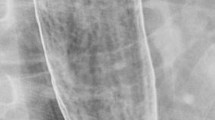Abstract
There are many opinions as to the accuracy of a patient's subjective localization of an obstructing esophageal lesion. However, there are few studies specifically examining this issue. Over a 35-month period, all patients evaluated by our gastroenterology service undergoing endoscopy for dysphagia were prospectively identified. The patient's subjective localization for the level of obstruction was evaluated by an investigator blinded to the results of prior barium esophagography and recorded on a schematic of the bony skeleton. At the time of endoscopy, the most proximal level of the obstructing lesion was documented. In all, 139 patients with dysphagia and an esophageal stricture were evaluated. Barium esophagograms were performed prior to endoscopy in all but nine patients (6.5%). The most common lesions causing dysphagia were carcinoma (34.5%), gastroesophageal reflux disease (22.3%), and a Schatzki's ring (15.8%). The level of obstruction was localized exactly in 30 patients (21.6%), within ±2 cm in 72 (52%), and within ±4 cm in 31 additional patients (74%). Eight patients (15%) with a distal esophageal lesion localized the obstruction to the proximal esophagus, whereas only two patients (5%) with a lesion in the proximal esophagus localized the level of obstruction to the distal esophagus. Overall, patients with distal obstructing lesions were more likely to have referral >6 cm proximally than proximal lesions with referral to the distal esophagus (P=0.003). There were no significant differences in accuracy based on the cause of dysphagia. In conclusion, a patient's subjective localization of the level of an esophageal stricture is highly accurate. Patients appear to be most accurate in localizing proximal rather than distal lesions.
Similar content being viewed by others
References
Castell DO, Donner MW: Evaluation of dysphagia: A careful history is crucial. Dysphagia 2:65–71, 1987
Edwards DAW: Diagnosis of oesophageal disorders. Br J Clin Pract 25:160–164, 1971
Edwards DAW: Discriminatory value of symptoms in the differential diagnosis of dysphagia. Clin Gastroenterol 5:49–57, 1976
Castell DO, Knuff TE, Brown FC, Gerhardt DC, Burns TW, Gaskins RD: Dysphagia. Gastroenterology 76:1015–1024, 1979
Richter JE: Heartburn, dysphagia, odynophagia, and other esophageal symptoms.In Gastrointestinal Diseases. MH Sleisenger, JS Fordtran (eds). Philadelphia, WB Saunders, 1993, p 334
Kramer P, Hollander W: Comparison of experimental esophageal pain with clinical pain of angina pectoris and esophageal disease. Gastroenterology 29:719–741, 1955
Payne WW, Poulton EP: Experiments on visceral sensation. The relation of pain to activity in the human oesophagus. J Clin Invest 10:435–452, 1931
Kahrilas PJ: Functional anatomy and physiology of the esophagus.In The Esophagus. DO Castell (ed). Boston, Little, Brown and Company, 1992, p 14
Author information
Authors and Affiliations
Rights and permissions
About this article
Cite this article
Mel Wilcox, C., Alexander, L.N. & Scott Clark, W. Localization of an obstructing esophageal lesion. Digest Dis Sci 40, 2192–2196 (1995). https://doi.org/10.1007/BF02209005
Received:
Revised:
Accepted:
Issue Date:
DOI: https://doi.org/10.1007/BF02209005




